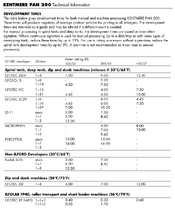Donald Qualls
Subscriber
How would I use the posted times for Ilford developers and D-76 to infer a good developing time for Rodinal or PC-TEA? (the developers I have on hand).
Look at developing times for other films in both D-76/ID-11 and your Rodinal or PC-TEA. If Rodinal 1:50 is pretty consistently, say, 50% longer than D-76 stock, then take whatever time Ilford gives for K200 in ID-11 or D-76 stock and add 50%. That may not be perfect, but you'll get printable/scannable negatives and you can adjust your time for the next roll if you want a little more or less contrast (10% more or less makes a visible difference, 20% is about a one stop push or pull).














